by Michael R. Allen

Some of the context for the history of the Nooter Corporation Building is found in my earlier article “A Brief History of the Kosciusko Urban Renewal Area” (June 19, 2011).
The modest two-story modernist office box located at 1400 S. Third Street south of downtown doesn’t evince its deep and important connections with historical forces as powerful as the development of atomic energy in the United States, St. Louis’ postwar effort to retain its manufacturing workforce and the mid-century modern architectural practice of a renowned engineering firm. Yet the red brick Nooter Corporation Building marks the intersection of these forces, at least through the administration of a company at the forefront of them. Here was the building that housed not the fabricators but the conjurers — those who dreamed of fitting an old boiler company into the mid-century mission of transforming America into modern nation.
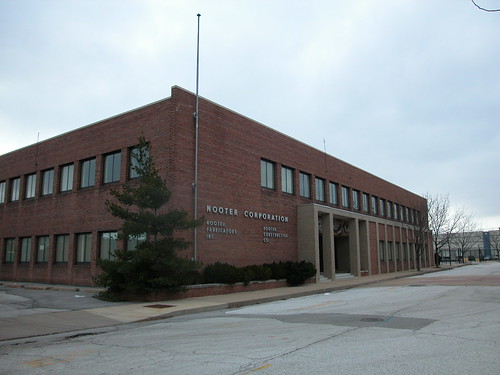
Following World War II, the Nooter Corporation entered into a rapid period of growth through involvement as a supplier and erector of process vessels to the emergent nuclear power industry as well as the established chemical, petroleum, food and defense industries. Nooter embarked on a major expansion of its plant in 1947 and by 1957 the corporation decided to build a new corporate headquarters suitable for its prominence. In 1959, administrative and engineering offices moved to the building.
From this office, engineers devised plans for the construction of a reactor vessel for the world’s first atomic energy plant and the world’s first use of titanium, tantalum and zirconium in reactive vessel construction. From 1964 through 1973, Nooter successfully applied for 13 patents, marking a major period of invention for the company. Nooter had not applied for a patent since 1954 and would not apply again until 1978. So the harmless little building in a tired old part of an ancient American city was actually an intellectual powerhouse from which ideas about new ways to make energy were born. Perhaps that is not surprising, since our buildings are often quiet keepers of great stories that may not initially seem to be linked to our own daily lives.
The Nooter Corporation, 1896-1958
The roots of the Nooter Corporation go back to the arrival of Dutch seaman John Nooter in St. Louis in the 1880s. Nooter took work at the John O’Brien Boiler Works, but by 1896 had started his own company, the John Nooter Boiler Works. The company began landing larger work related to boiler-making and riveted smokestack construction, including extensive involvement in the Louisiana Purchase Exposition in 1904. By 1911, Nooter and his partners Tom Ryan and John Eschmann, Sr. had enough steady activity to be able to purchase land near the riverfront in Kosciusko where they built their first factory building. For the next decade, the John Nooter Boiler Works mostly built horizontal return tubular boilers and steel smokestacks. By the mid-1920s, Nooter began welding vessels in carbon steel and electric welding. Nooter began to shift toward custom fabrication of metal plate products for industrial and commercial clients. World War II provided both a disruption of normal business work and the chance to develop new products, including those utilizing stainless steel. Focusing on work for the military, Nooter chiefly manufactured process vessels for explosives, gasoline, synthetic rubber and penicillin manufacturing.
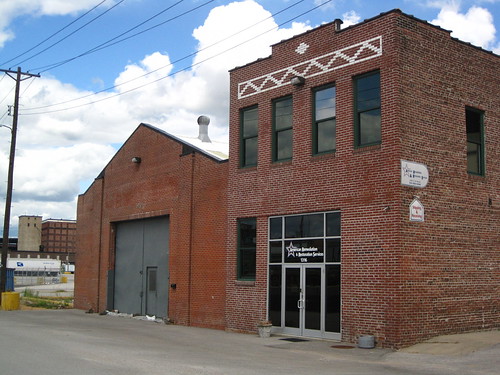
Nooter’s work on process vessels for penicillin manufacturing helped enable large-scale production of that important drug. Before World War II, the availability of pencillin was scarce. The United States Army was interested in increasing availability because the drug could cure gangrene, a frequent infection on battlefields. In response to the military need, Nooter developed cylindrical production tanks that ranged in capacity from 2,500 to 25,000 gallons. These tanks were partly filled with a culture on which mold formed, and kept an even high temperature by a steam pipe lining the tank. The mold then produced a liquid from which penicillin could be extracted. This process revolutionized the availability of a common “wonder drug†used widely to this day. According to a quote from Army Lt. Col. Richard Coward that appeared in a 1944 newspaper article, prior to Nooter’s invention of those tanks penicillin could not be produced in any container larger than a milk bottle and scientific magazines had suggested that the drug would never be mass-produced.

A catalog from 1946 boasts that Nooter was able to oversee each step of the metal fabrication process: engineering, layout, fitting-up, welding, inspection and testing of products in copper, nickel, aluminum, steel and stainless steel. A 1947 article stated that the company was preparing a $300,000 expansion program and had a labor force of 400. While the Kosciusko district around the plant was experiencing decline, and many local industries were migrating to suburban St. Louis County where large expanses of open land were available, Nooter instead invested in its historic location. The expansion project added 50,000 square feet of enclosed space to the plant, and brought the total size of the plant to eight acres. The expansion led to a 40% increase in the size of Nooter’s workforce and the use of new equipment, including a car-loaded annealing furnace (used in fabricating stress-relieving and stainless steel products) among the nation’s largest at the time. This impressive expansion project came a decade before the city government decided to make a substantial investment in the Kosciusko district to create space for industrial expansion.
In 1949, the Nooter Boiler Works renamed itself the Nooter Corporation to reflect its changed production emphasis; it had not built a boiler since the late 1930’s. New lines of work emerged, including metal spraying or metallizing in which metal products are sprayed with coatings of other metals, like aluminum, for rust and corrosion resistance. In the next decade, the company started using zirconium in fabrication. One of the notable company achievements of the 1950s was the fabrication of the vessels used in manufacturing the newly-developed polio vaccine. Another major area of concentration in this decade was work for the petroleum industry. According to the account of one former executive, by the late 1950s orders for generator tanks and transformer tanks were particularly high, with sales to power plants booming. In 1954, Nooter had merged with one of its chief local competitors, the Missouri Boiler and Sheet Iron Works, which became a division of the larger company. Nooter’s growth seemed boundless.
In 1956, Nooter also began its entry into the new field of atomic energy with the development of a gold-lined portable atomic power generator for the renowned Los Alamos Scientific Laboratory at the University of California. While the new generator itself was remarkable, so was fabrication with gold. The domestic metal fabricating industry had not yet seen fabrication with gold until Nooter’s successful experiment. Although Nooter had grown progressively since the end of World War II, the company was still considered small in terms of its workforce (then around 800 people). At the time, Nooter President Robert J. Ryan extolled the virtues of Nooter’s size: “Our greatest virtues are our flexibility and our size — the smaller you are, the more attention you can give to one job.” Ryan stated that the company would remain a custom shop, a status that made it one of the country’s most innovative and willing developers of new process vessels, containers, reactors and other fabricated metal products.
Although the earlier expansion had created state of the art fabrication facilities for Nooter, the company did not have a suitable office building for the executive, administrative and engineering offices from which future growth would be directed. In 1957, the company began planning for the new Nooter Corporation building to be built at the east side of their plant on South Third Street. The company hired noted engineering and architectural firm Sverdrup & Parcel to design the new office building. Sverdrup & Parcel, which also diversified its work taking government contracts during World War II, had only recently begun offering architectural services to its array of services. At the same time the company planned growth, the city government was readying a vast campaign for urban renewal in the Kosciusko district around the Nooter plant. Mindful of the recent start of the suburban exodus of business, city planners were seeking to transform the area into an industrial district with ample room for expansion. Nooter’s plans fit right into those of the city.
At the same time, developments in nuclear power were forging a new direction for plate metal fabricators like Nooter. In 1957, the first nuclear power plant in the United States went online in California; Nooter would later supply a reactor vessel for that plant. Nuclear power plants are centered on contained and controlled nuclear chain reactions with uranium as fuel. The chain reaction is confined in a reactor vessel, and the energy created is typically used to heat water that powers steam generators capable of creating electricity. Nuclear power plants required formidable metal reactor vessels, tubes, generators and turbines able to withstand corrosion. Alloy-plated steel was an early material used in construction of the plants, but Nooter built upon its recent innovations in atomic energy technology by developing new fabricated products. After construction of its new office building, the company would become supplier to several of the first wave of nuclear power plants in the nation. This involvement led to a major fabrication breakthrough of national significance.
The Nooter Corporation Building, 1958-1959
Nooter Corporation planned a new office building in 1957, simultaneous with city government’s plans for a major urban renewal project in the Kosciusko district that includes the Nooter plant. The renewal project called for clearance of much of the area to create expansion space for the many existing industrial facilities in the area. On March 28, 1958, the city granted Nooter Corporation a building permit for the office building with cost projected as $763,224.
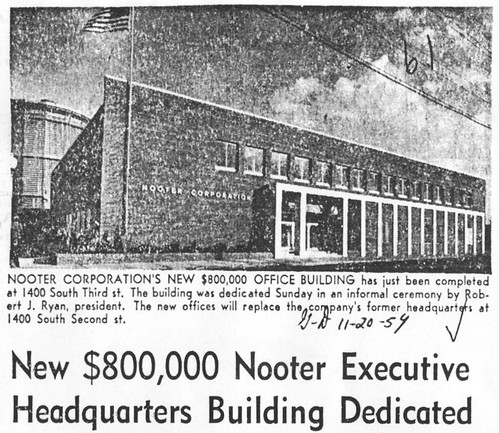
The Nooter Corporation Building was one of the earliest architectural endeavors by engineering giant Sverdrup & Parcel, which had been founded by Leif J. Sverdup and his former professor John Ira Parcel in 1928 to design bridges. Sverdrup and Parcel diversified its services to include all types of engineering and eventually architectural design. Funding of the federal interstate highway program in 1954-5 led to so much work that a new company was created to exclusively handle that work. Sverdrup & Parcel retained the other largely domestic engineering and architectural projects, including the massive Chesapeake Bay bridge and tunnel system. Architectural projects from the 1950s typically involved large-scale facilities or campus components, ranging from stadia to factories to office buildings. The Nooter Corporation Building thus serves as an early example of the firm’s architectural work in more visible urban settings. The company’s staff handled the commission with characteristic willingness to master the new situation, and designed an elegant urban office building with careful attention to materials and proportion. Throughout the 1960s, Sverdrup & Parcel’s architectural division became stronger, and tackled important projects including the terminal building at the 1964 World’s Fair in New York and, in collaboration with architect Edward Durell Stone, Busch Stadium in St. Louis (completed in 1966 and razed in 2005). Later restructuring of the company led to increased focus on design/build and construction management contracts, as well as the new name “Sverdrup Corporation.”
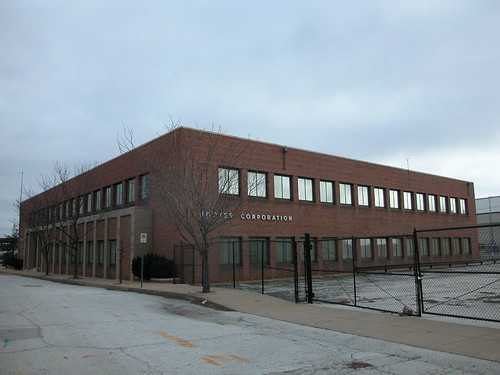
On July 1, 1958, St. Louis Mayor Raymond Tucker spoke at the groundbreaking ceremony, hailing the construction project as “physical evidence of community efforts to revitalize [Kosciusko].” Construction was completed the following year, and the building was dedicated on November 20, 1959. The new building provided 46,000 square feet of modern office space on two stories. Sverdrup & Parcel’s design was sleek and minimalist, while making use of materials with long local traditions. Like many twentieth-century St. Louis office buildings, the flat-roofed Nooter Corporation Building had a steel-frame, polychrome red brick cladding with some terra cotta surrounds on the first floor, a flat roof and a terrazzo floor in the lobby. However, the design was part of the Modern Movement that was shaping the region’s commercial architecture.
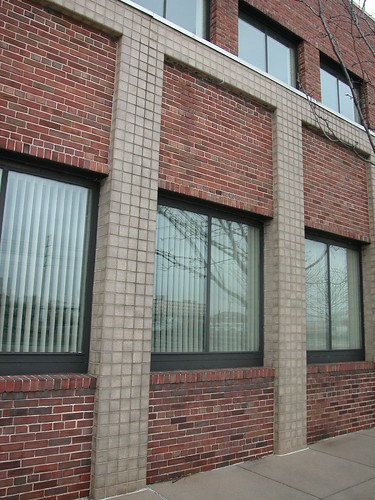
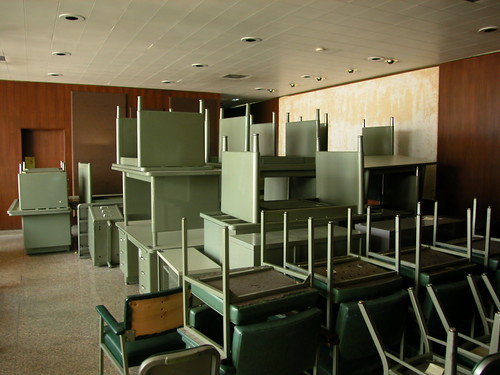
Rather than emphasize the verticality, the building emphasized its width. Rather than evoke classical architecture through ornament, the variation in masonry and use of terra cotta tiles on the Nooter Corporation Building created imagistic contrasts of colors, textures and materials. The building emphasized the right angle, with few curves or traces of decoration. Modern technologies used on the building included central air conditioning and double-glazed aluminum windows (still extant) with light and glare control. The 140-by-160-foot Nooter Corporation Building was as spartan as the products of the company itself. In fact, Nooter plant engineer Harvey Yaeger was actually manager of the construction of the building.
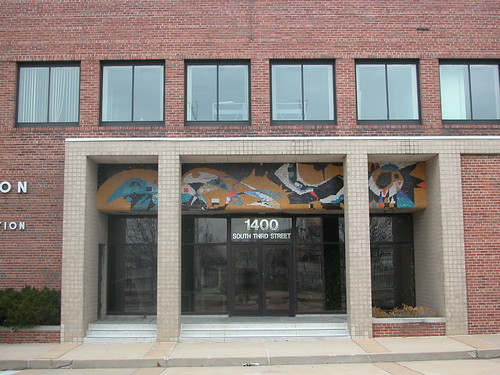
However, there were two notable decorative touches: a 16-by-7-foot mural in the lobby depicting boilermakers at work by noted artist Siegfried Reinhardt (now removed) and a mosaic of ceramic tiles above the recessed entrance designed by Reinhardt. According to former Nooter corporate communication manager William Schawacker, the mural above the entrance was an abstraction of the themes of the painted mural inside of the lobby. Reinhardt (1925-1984) was noted for both his canvas architectural murals and his architectural mosaics, much of which was religious in nature. Some of his extant works in St. Louis include the Te Deum mosaic at Walther Library at Concordia Theological Seminary, reredos at St. John’s Methodist Church and a 142-foot mural in the main terminal of Lambert International Airport. Reinhardt’s mosaic mural here is one of his few known surviving commercial commissions.
Nooter Corporation Engineering Achievements, 1959-1972
In the thirteen years following completion of the Nooter Corporation Building, the engineering department hit a research and development stride. Between 1964 and 1973, the US Patent Office reported Nooter as assignee of 13 patents related to metal fabrication. Prior to this period, Nooter’s last patent application had been in 1954. Alongside the coming innovation, Nooter would continue to manufacture process vessels for penicillin and polio vaccination production.
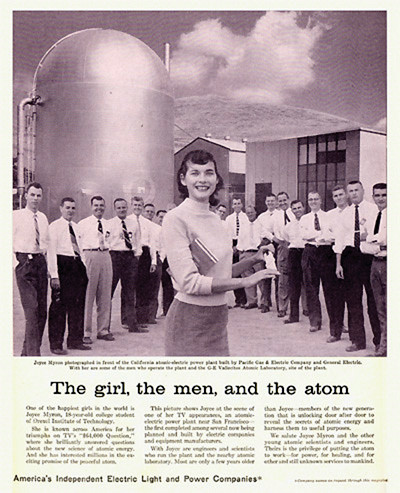
Continued corporate growth and innovation came with nuclear power projects. In 1961, Nooter built its first nuclear power reactor vessel, for the General Electric Company’s Vallecitos Atomic Laboratory (now the Vallecitos Nuclear Center) in California. The stainless steel vessel was an 80-ton “superheat†reactor built for experimental use. The St. Louis Globe-Democrat reported that the superheat reactor worked by “utilizing nuclear superheat to raise the temperature of steam produced in the Vallecitos boiling water reactor to levels achieved in conventional steam-generated plants using modern turbine equipment.†Vallecitos was an experimental power plant where the first superheat reactor had been tested in 1957; it is reputed to be the first nuclear power plant in the world to deliver significant amounts of electricity to a public utility grid.
In July 1961, Nooter President Robert Ryan announced a $1 million expansion of the fabricating shops at the plant. A newspaper article stated that “the growing needs of the nuclear age†was the reason for the expansion of the plant. As part of the project, Nooter expanded the floor space of a fabricating building east of the headquarters building by 50,000 square feet. New equipment was added to allow for the production of vessels of 250 tons, doubling the existing size capacity of the plant. Upon completion of the expansion in 1962, Nooter was able to build a new type of straining tank for the Anheuser-Busch brewery that the brewing company had recently patented. The stainless steel “Strainmaster†tank had no internal straining parts.
A postcard booklet issued in 1963, This is Nooter Corporation, shows significant expansion of advertised products. The booklet stated that Nooter could work with metal from “14 gauge to 6″ thick with a maximum lifting capacity of 350 tons.” The booklet listed industries served by the corporation as “chemical, petroleum, pharmaceutical, brewing, nuclear power, food, munitions, aeronautical and space.” The booklet also emphasized that Nooter’s workers were “steel and alloy plate fabricators and erectors … ‘boilermakers’†showing the evolution of the company’s identity. Showcased also was Nooter’s growing experience in on-site building of process facilities around the United States.
Also in 1963, Nooter began fabrication with solid titanium, zirconium and tantalum; these reactive metals are highly resistant to corrosion. According to a history of the company, Nooter was the world’s first company to use these three metals in reactive metal clad welding. In January 1964, Nooter engineers applied for a patent for the application of non-corrosive metals as cladding in reactive metal-clad pressure vessels and heat exchangers used in nuclear power production, brewing and other processes. The invention used a rotating pressure roller that inserted a continuous corrosion-resistant lining of a corrosion-resistant metal like stainless steel, zirconium or titanium. The Patent Office granted this important patent in April 1967. A related patent for the vessel lining apparatus has an application date of January 1964 and an issue date of October 1969.
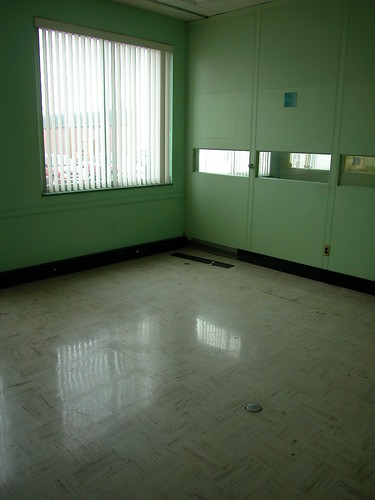
Nooter followed these important patented inventions with others. In February 1966, Nooter engineer Charles Woelfner applied for patents for both multi-layer (or plywall) vessels and the method of fabricating them. Nooter’s engineers had perfected fabrication of vessels which were internally clad with flat non-corrosive metal sheets applied in a spiral fashion to desired thickness. Previously, no fabricator had been able to apply flat metal sheets to the interior of rounded process vessels. Such an application of non-corrosive metals was pivotal, though, for petrochemical processes. The Patent Office issued the patent for the vessels in November 1969 after issuing a patent on the method in June 1968.
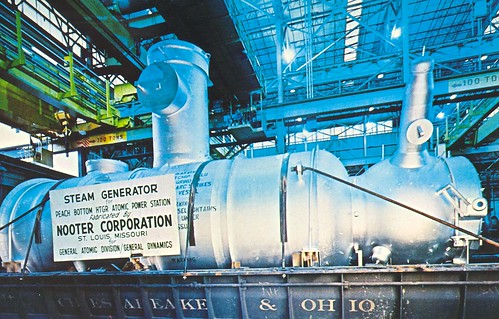
Also during the 1960s, Nooter also developed plasma arc weld overlay techniques and other new fabricating technologies. According to one account, “Nooter enjoyed the reputation as the premier custom fabricator of stainless steel, duplex stainless steels, nickel alloys, Hastelloy alloys, and reactive metal (titanium, zirconium and tantalum) both solid and clad equipment.” The unique patents led to Nooter’s entrance on the international market through an active exporting program. Subsequently, Nooter became involved with the U.S. space program.
In July 1972, Nooter applied for a patent on corner construction for tank reinforcing ribs made from thin sheet metal. This patent, issued in December 1973, was the last patent the company would receive until 1980 and marks an end to the height of Nooter’s inventions. Also in 1972, Nooter announced major expansion plans for the facilities in Kosciusko to keep up with corporate growth. The corporation built a large fabrication building, still extant, just east of the office building. In this building Nooter added a “heavy fabricating bay,” increased the size of shop crane facilities and expanded its barge loading dock. This expansion cost $10 million and created 500 jobs; the building took two years to build. The completed structure was a large steel-framed building clad in transite siding that contained and expanded a 1947-era building. The company continued to grow, adding subsidiaries over the years and expanding its exports. However, construction of the new manufacturing building marked the end of development of the Kosciusko plant.
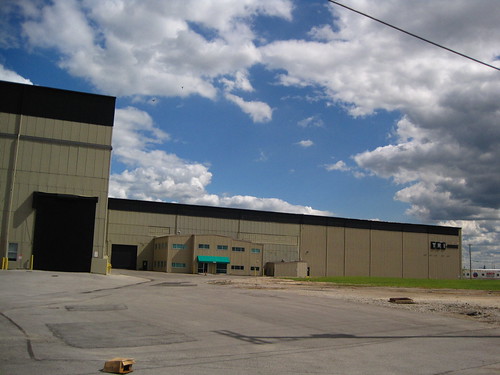
In 1998, Nooter Corporation sold the fabrication shop to Nooter Fabricators, a subsidiary. In 2001, Nooter Corporation decided to relocate all of its manufacturing operations from its historic location and convert the plant into a business center. That same year, Nooter Fabricators closed its St. Louis shop, eventually licensing its patents with other companies. The conversion plans fell through, but Nooter left the old plant including the Nooter Corporation Building by 2003, moving some operations to a nearby new building and others to suburban Fenton. Much of the Kosciusko plant was demolished. Kirberg Roofing purchased the Nooter Corporation Building in 2007, had it listed in the National Register of Historic Places and rehabilitated the building using state and federal historic tax credits. Near the building are Nooter’s first office building and one large fabrication building, all forming the ghost landscape of one of St. Louis’ greatest lost industrial giants.
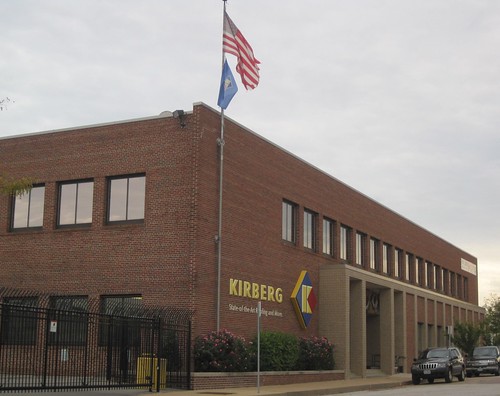
This article is adapted from the National Register of Historic Places nomination that I wrote for the building while an employee of Landmarks Association of St. Louis.
Bibliography
City of St. Louis building permits and data engineering records. St. Louis City Hall, Microfilm Department.
Flannery, William. “Nooter is Making its Mark Making Weighty Products.” St. Louis Post-Dispatch, 6 May 1996.
“Industrial and Commercial Development.” St. Louis Commerce 33.12 (December 1959).
Delugach, Al. “Kosciusko Area Project May Be Completed in ’67.” St. Louis Globe-Democrat, 24 November 1966.
“Final Phase of Nooter Plant to Begin This Week.” St. Louis Globe-Democrat, 19 December 1948.
Franzwa, Gregory M. and Lt. Gen. William J. Ely. Leif Sverdrup: Engineer Soldier at His Best. Gerald, Mo.: The Patrice Press, 1980.
Matthews, Curt. “Employee Ownership Plan Helps Stabilize Nooter’s Work Force.” St. Louis Post-Dispatch, 21 April 1967.
“Missouri Boiler Works Merges, to Be Division of Nooter Corp. Here.” St. Louis Globe-Democrat, 1 December 1954.
“New $800,000 Nooter Executive Headquarters Building Dedicated.” St. Louis Globe-Democrat, 20 November 1959.
“Nooter Corporation.” International Directory of Company Histories, Vol. 14. New York: St. James Press, 1996.
“Nooter Fabricates New Type Tank.” St. Louis Globe-Democrat, 28 September 1962.
Nooter St. Louis. St. Louis, Mo.: Nooter Boiler Works, 1946.
“Nooter Shipping Atomic Component.” St. Louis Globe-Democrat, 26 February 1964.
“Nooter to Build G.E. Nuclear Vessel.” St. Louis Globe-Democrat, 9 February 1960.
“Nooter to Spend $1 Million, Hike Employment 10 Pct.” St. Louis Globe-Democrat, 18 July 1961.
Openso Corporation: The Wordlwide Licensee of Nooter Corporation for Selected Technologies. 2003.27 September 2007.
Ryan, Robert J. “Blast Furnace Among Projects of Nooter Corporation.” St. Louis Globe-Democrat, 2 January 1957.
“St. Louis Tomorrow.” St. Louis Globe-Democrat, 8 December 1958.
Schafers, Ted. “Gold-Lined Portable Atomic Power Plant.” St. Louis Globe-Democrat, 29 April 1956.
—. “Nooter plans to expand its St. Louis plant.” St. Louis Globe-Democrat, 18 October 1972.
Schawacker, William, interview with Michael Allen. 28 February 2007.
“Sverdrup Corporation.” International Directory of Company Histories, Vol. 14. New York: St. James Press, 1996.
“Tanks Made Here Put Penicillin in Mass Production.” St. Louis Globe-Democrat, 4 March 1944.
Terry, Dickson. “Labor Leader Pays Tribute to Industrial Relations Policy of St. Louis Plant.” St. Louis Post-Dispatch, 9 November 1947.
This Is Nooter Corporation. St. Louis: Nooter Corporation, 1963.
Urban Renewal Plan for the Kosciusko Urban Redevelopment Area. St. Louis: LCRA, 1958.
The Vallecitos Boiling Water Reactor. Pleasanton, California: American Society of Mechanical Engineers, Mt. Diablo Section, 1987.
“Work Starts on Nooter Corp. Office Building.” St. Louis Globe-Democrat, 2 July 1958.

4 replies on “The Nooter Corporation Building: Urban Renewal, Atomic Power and Mid-Century Modernism”
Nooter is great, eh?
So, what happened to the big neon sign? Demolished as well? Still miss Big Greeny.
Yes, demolished around 2005.
Another legacy of Ross Osisk